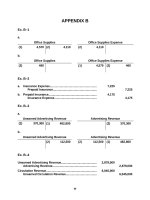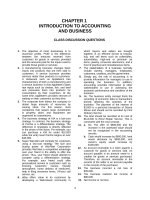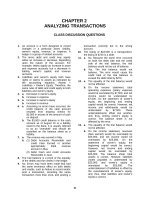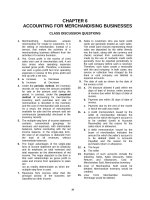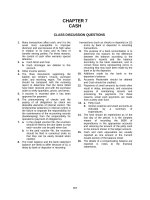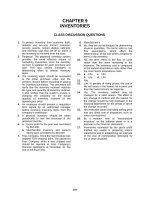Solution manual investments 10th by jones ch14
Bạn đang xem bản rút gọn của tài liệu. Xem và tải ngay bản đầy đủ của tài liệu tại đây (150.81 KB, 12 trang )
Chapter 14:
Industry Analysis
CHAPTER OVERVIEW
Chapter 14 covers industry analysis, the intermediate or
second step in the fundamental analysis of common stocks which
starts with market analysis and concludes with company analysis.
As such, it is designed to cover the essentials of thinking about
and analyzing industries without being overly technical.
The philosophy behind Chapter 14 is important to note.
Beginning students in Investments are unable to do detailed
fundamental analysis, both because of knowledge limitations and
time constraints. The author thinks it is unrealistic to ask
students to do detailed industry analysis, involving tax rates,
depreciation charges, and so forth. Therefore, the emphasis in
Chapter 14 is on the conceptual issues: Why do we do industry
analysis, what are the problems involved, and how should we
conceptually go about doing industry analysis?
In the final analysis, the point is made that industry
analysis, like all aspects of fundamental analysis, comes down to
estimating the future expected cash flows and discounting these
cash flows at a proper discount rate, or using the estimated
earnings for the industry next year and an appropriate P/E ratio.
It is more important to get students to think about the
conceptual issues involved in doing security analysis than in too
many details of industry analysis that most will not understand
or use again.
Chapter 14 first documents the importance of industry
analysis by showing how some industries outperform others over
various time periods. There is no doubt that some industries
outperform others over long periods of time. The discussion next
demonstrates that short-term consistency is very difficult to
find, which means that we cannot simply buy the industries that
performed well last year and expect them to perform well this
year. In many cases the opposite is true--bad performers for one
year become good performers in the next year or the year after
that. Therefore, investors interested in both long-term
performance and shorter-term performance must do industry
analysis.
198
Chapter 14 also examines such issues as the definition of
industries and the problem with classifying a particular company
in one industry. The industry life cycle, which is often used as
part of industry analysis, is explained as a conceptual method of
analyzing industries. The implications of business cycle
analysis for industries are considered, which provides useful
classifications for industries such as growth industries,
defensive industries, cyclical industries, and interest-sensitive
industries.
Qualitative aspects of industry analysis are presented,
including brief excerpts from the well-known Porter material on
industry analysis. Two well-known diagrams from the Porter
analysis on industries, one showing the five competitive forces
that determine industry profitability and one showing the
elements of industry structure, are included in the discussion.
Once again, this analysis is consistent with the approach
emphasized on the CFA examinations, particularly at Level II.
The sources of industry information are covered in an
appendix, consistent with the philosophy of having descriptive
material such as this in an appendix.
CHAPTER OBJECTIVES
To demonstrate why industry analysis is an important component
of fundamental analysis, and why we must do industry analysis.
To explain conceptually how to analyze industries. The
emphasis is on the broad conceptual approach, and not the
specific details which cannot readily be mastered by
beginners.
To discuss various aspects involved in industry analysis.
central focus of this material is some excerpts from the
Porter analysis.
199
A
MAJOR CHAPTER HEADINGS [Contents]
Performance of Industries over Time
The Importance of Industry Analysis Over Long Periods
[comparisons of industry price indices over various periods]
Consistency of Industry Performance
[consecutive-year performance comparisons show instability]
What Is an Industry?
[problems in determining what industry a company is in]
Classifying Industries
[SIC system, other classifications such as Value Line]
Analyzing Industries
The Industry Life Cycle
[pioneering; expansion; stabilization; implications for
investors]
Qualitative Aspects of Industry Analysis
[historical; competition; government; structural changes; the
Porter analysis--five competitive forces and elements of
industry structure]
Evaluating Future Industry Prospects
[brief verbal explanation of how to do this]
Assessing Longer-Term Prospects
Picking Industries for Next Year
[some empirical findings]
Business Cycle Analysis
[growth industries; defensive industries; cyclical industries;
interest-sensitive industries]
Appendix 14-A
Sources of Industry Information
[general information--S&P, Forbes, etc.; specific
information]
POINTS TO NOTE ABOUT CHAPTER 14
Tables and Figures
Table 14-1 is useful for discussion purposes about the
performance of various industries over time and the consistency
of performance over short periods. This table illustrates the
large differences that occur in industry performance over time,
both over long periods and over shorter periods.
Two points should be emphasized. It clearly matters which
industries an investor buys into over long periods of time
because some industries are going to perform very well, and some
very poorly. A second important issue is whether future
performance can be predicted from past performance. The evidence
presented here suggests that while some continuation occurs, it
is not readily apparent that the future strong performers can be
predicted from past performance. This should come as no surprise
in investing.
Figure 14-1 illustrates the industry life cycle. This is a
simple but well-known part of industry analysis which does
provide some valuable insights.
Figure 14-1 shows Porter’s five competitive forces that
determine industry profitability. This discussion is based on
well-known work by Porter on the issue of competitive strategy,
which involves the search for a competitive position in an
industry.
Figure 14-2 is a follow-up to Porter’s work. While the five
competitive forces determine industry profitability, the strength
of each of these factors is a function of industry structure.
Exhibit 14-2 shows the important elements of industry structure.
Box Inserts
Box 14-1 is an interesting discussion of a technique
suggested by S&P in its publication, The Outlook. It indicates
that picking industries on the basis of their prior year's
performance relative to the S&P 500 Index can produce superior
results. What is interesting about this is that both last year’s
leaders and last year’s laggards are recommended, as long as they
are exhibiting upward momentum.
ANSWERS TO END-OF-CHAPTER QUESTIONS
14-1.
It is difficult to classify industries because of
the problem of determining in which industries
particular companies belong. Companies often cross
traditional industry lines. Industries continue to
become more mixed in their activities and less
identifiable with one product or service. At best,
industries cannot be identified casually.
14-2.
Industry analysis is valuable because industries
have turned in widely-varying performances in the
past, and undoubtedly will continue to do so in the
future. Investors’ results have been greatly
affected by the industries in which they invested.
Some industries’ price performance have been
virtually flat over long periods, while others show
very large gains.
14-3.
Obviously, differences of opinion will exist about
industries expected to perform well in the future.
In the next five years (i.e., roughly 2000-20005),
such industries as information/communications and
medical technology (artificial organs, genetic
engineering, etc.) may do well. Over the next 10 to
15 years, instructors and students are free to make
their own choices.
14-4.
Year-to-year industry performance is not consistent.
Investors cannot simply choose industries performing
well in the recent past and expect this to continue
over the next several years.
14-5.
The stages of the industry life
pioneering stage, the expansion
stabilization stage. It is also
a fourth stage--decline, either
relative basis.
14-6.
The internet-related activities, such as E-commerce,
is in the pioneering stage. The medical service
industry is in the expansion stage as is cellular
phones. The supermarket industry is in the
stabilization stage, as is the electric utility
industry. Declining industries could include, as
possibilities, steel and metals and mining.
cycle are the
stage, and the
possible to talk of
on an absolute or a
14-7.
The pioneering stage offers the greatest risk.
14-8.
Cyclical industries, such as autos, appliances, and
houses, are the most sensitive to the business
cycle. Defensive industries, such as the food
industry, are the least affected by recessions and
economic adversity.
14-9.
Investors should analyze the stage of the business
cycle and the likely movements in interest rates.
As the economy approaches a recession, cyclical
industries are likely to be more affected than other
industries while defensive industries will be least
affected. An expected rise in interest rates will
have adverse consequences for such industries as
homebuilding and savings and loans.
14-10.
The fundamental valuation of industries is based on
the same concept of valuation used throughout the
book. Specifically, it is necessary to estimate the
expected returns (earnings or dividends) and a
multiplier (or, alternatively, a discount rate) for
industries, as was done in the preceding chapter
with the market, or as will be done in the next
chapter with individual companies.
14-11.
Several sources of information would be useful to an
investor doing a detailed industry analysis.
•
•
•
•
•
•
Standard & Poor’s Industry Survey provides
basic data.
Dun & Bradstreet Key Business Ratios provides
ratio information.
The Quarterly Financial Report for
Manufacturing, Mining, and Trade Corporations,
a government publication, provides timely
information on individual industries.
Forbes magazine rates industry performance
annually in its January issue. This gives
investors calculated information for a five
year period.
The Media General Financial Weekly publishes
up-to-date weekly information on about 60
industries, showing recent price performance.
The Value Line Investment Survey estimates
industry statistics for both the current year
and the coming year, and ranks all industries
covered in terms of timeliness (probable
performance over the next 12 months).
14-12.
CFA
14-13.
Figure 14-A1 (from Value Line) shows the industries
covered by Value Line (typically, between 90 and
100) ranked in order of timeliness--probable
performance over the next 12 months. Investors
should pay attention to those industries ranked at
the top in searching for stocks to buy. This does
not mean that other stocks are not good buys, but
that stocks in the top-ranked industries are likely
to perform better. Investors should consider
avoiding stocks in the industries ranked at the
bottom in terms of near-term performance. On the
other hand, some stocks in these industries are
probable turnaround situations.
Note: Candidates could select any three of the
following five competitive forces and then relate
those selected to both Ford and Merck.
1.
2.
Rivalry among existing firms.
a)
Ford faces intense competition from other
domestic and foreign auto manufacturers.
b)
Merck has a dominant market share in many
of its product lines because a limited
number of companies can supply specific
drugs. For many of its most profitable
drugs, Merck faces no competition for an
extended period of time because of patent
protection. Hence, Merck's dominant
market share and limited competition allow
it to develop strategies of product
differentiation and focusing on market
segments.
Threat of new entrants.
a)
Despite substantial capital requirements
and technological barriers to entry,
domestic auto manufacturers have seen
foreign manufacturers establish strong
market positions.
b)
3.
4.
5.
The drug industry has natural barriers to
entry as years of research are required to
develop competing products and receive FDA
approval to market. Once patent
protection has been achieved, Merck can
take advantage of product differentiation
and focus on market segments.
Threat of substitute products.
a)
A Lexus can be substituted for a Lincoln
and a Chevy for a Ford. In addition, some
buyers can substitute other products such
as motorcycles for cars.
b)
Some drugs provide unique therapy while
others have limited prescription
substitutability. Again, Merck can focus
on market segments and differentiate its
products.
Power of buyers.
a)
A car buyer has several alternatives among
different brands and modes of
transportation. In addition, the
potential buyer can defer purchase by
repairing an older car. Accordingly,
manufacturers are often forced to
provide rebates to stimulate sales,
cutting profit margins.
b)
Drugs, on the other hand, are aimed at
specific ailments, and potential
purchasers are unlikely to defer purchase
once the drug has been prescribed by a
doctor. Frequently, insurance companies
or the government picks up the cost of the
prescription. Accordingly, drug companies
have a great ability to increase prices
with little consumer resistance. Again,
Merck can focus on market segments.
Power of suppliers.
CFA
14-14.
A.
a)
In theory, Ford should have an advantage
here because auto manufacturers exercise
great control over their suppliers. Some
of these suppliers have Ford as their
major customer. This could be important
in cost containment. However, there are
no hints in the financial statements that
Ford has been able to exploit its power
over suppliers in recent years.
b)
Merck has no special advantages in dealing
with its suppliers.
The concept of an industrial life cycle refers
to the tendency of most industries to go
through various stages of growth somewhat
resembling those of a person. Generally four
stages are talked about with no uniformity in
the length of each stage. The rate of growth,
the competitive environment, profit margins and
pricing strategies tend to shift as an industry
moves from one stage to the next although it is
usually difficult to pinpoint exactly when one
stage has ended and the next has begun.
The initial stage is characterized by
perceptions of a large market and by a high
optimism for potential profits. Little or no
profits are usually achieved, however, in this
stage and there is usually a high rate of
failures. In the second stage, often called
rapid expansion or follow-through, growth is
high and accelerating, the markets are
broadening, unit costs are declining and
quality is improving. The third stage, usually
called mature growth, is characterized by
decelerating growth caused by such things as
maturing markets and/or competitive inroads by
other products. Finally, an industry reaches a
stage of full maturity in which growth slows or
even declines.
Product pricing, profitability and industry
competitive structure often (though not
necessarily) vary by phase. Thus, for example,
the first phase usually encompasses high
product prices, high costs (R&D, marketing,
etc.) and a (temporary) monopolistic industry
structure. In phase two (rapid expansion), new
entrants appear and costs fall rapidly due to
the experience curve. Prices generally don't
fall as rapidly allowing profit margins to
increase. In phase three (mature growth),
growth begins to slow as the product or service
begins to saturate the market, and significant
price reductions become less common. There’s a
choking out of competitors as quality and other
non-price factors become more important as
competitive tools. In the final stage,
industry cumulative production is so high that
production costs have stopped declining, profit
margins are thin (assuming competition exists),
and the fate of the industry depends on the
extent of replacement demand and the existence
of substitute products/services.
B.
The passenger car business in the United States
has probably entered the final stage in the
industrial life cycle because normalized growth
is quite low. The information processing
business, on the other hand, is undoubtedly
earlier in the cycle. Depending on whether or
not growth is still accelerating or not, it is
either in the second or third stage.
C.
Cars: In the final phases of the life cycle,
demand tends to be price elastic. Thus,
Universal can't raise prices without losing
volume. Moreover, given the industry’s
maturity, cost structures are likely to be
similar across all competitors, and any price
cuts are likely to be matched immediately.
Thus, Universal’s car business is boxed-in-product pricing is determined by the market-the company is a “price-taker.”
Idata: Idata should have much more pricing
flexibility given its phase in the industrial
life cycle. Demand is growing faster than
supply, and, depending on the presence and/or
actions of an industry leader (umbrella or
experience curve pricing), Idata may price high
to maximize current profits and generate cash
for product development or price low in an
effort to gain market share.
